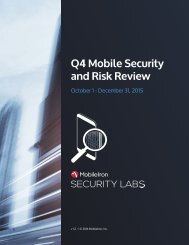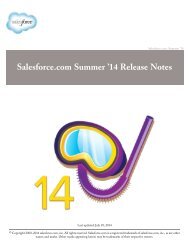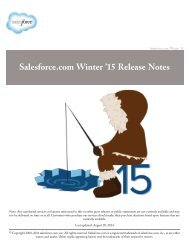salesforce_security_impl_guide
salesforce_security_impl_guide
salesforce_security_impl_guide
You also want an ePaper? Increase the reach of your titles
YUMPU automatically turns print PDFs into web optimized ePapers that Google loves.
Securing and Sharing Data<br />
Roles Overview<br />
On the Customer Portal Setup page, click Del next to all available sharing sets for HVPUs.<br />
After user visibility is restored to the defaults, all internal users are visible to each other, portal users under the same portal account are<br />
visible to each other, and community members in the same community are visible to each other.<br />
Roles Overview<br />
Salesforce offers a user role hierarchy that you can use together with sharing settings to determine<br />
the levels of access users have to your organization’s data. Roles within the hierarachy affect access<br />
on key components like records and reports.<br />
Watch how you can open up access to records using the role hierarchy if your<br />
organization-wide defaults are more restrictive than Public Read/Write.<br />
Who Sees What: Record Access via the Role Hierarchy<br />
EDITIONS<br />
Available in:<br />
• Professional<br />
• Enterprise<br />
• Performance<br />
• Unlimited<br />
• Developer<br />
• Database.com<br />
Depending on your organization’s sharing settings, roles can control the level of visibility that users<br />
have into your organization’s data. Users at any given role level can view, edit, and report on all<br />
data owned by or shared with users below them in the role hierarchy, unless your organization’s<br />
sharing model for an object specifies otherwise. Specifically, in the Organization-Wide Defaults<br />
related list, if the Grant Access Using Hierarchies option is disabled for a custom object, only the<br />
record owner and users granted access by the organization-wide defaults receive access to the<br />
object's records.<br />
USER PERMISSIONS<br />
To create, edit, and delete<br />
roles:<br />
• “Manage Roles”<br />
To assign users to roles:<br />
• “Manage Internal Users”<br />
About Groups<br />
Groups are sets of users. They can contain individual users, other groups, the users in a particular<br />
role or territory, or the users in a particular role or territory plus all of the users below that role or<br />
territory in the hierarchy.<br />
There are two types of groups:<br />
• Public groups—Only administrators can create public groups. They can be used by everyone<br />
in the organization.<br />
• Personal groups—Each user can create groups for their personal use.<br />
You can use groups in the following ways:<br />
• To set up default sharing access via a sharing rule<br />
• To share your records with other users<br />
• To specify that you want to synchronize contacts owned by others users<br />
• To add multiple users to a Salesforce CRM Content library<br />
• To assign users to specific actions in Salesforce Knowledge<br />
EDITIONS<br />
Available in:<br />
• Professional<br />
• Enterprise<br />
• Performance<br />
• Unlimited<br />
• Developer<br />
• Database.com<br />
Public Group Considerations<br />
For organizations with a large number of users, consider these tips when creating public groups to optimize performance.<br />
72






